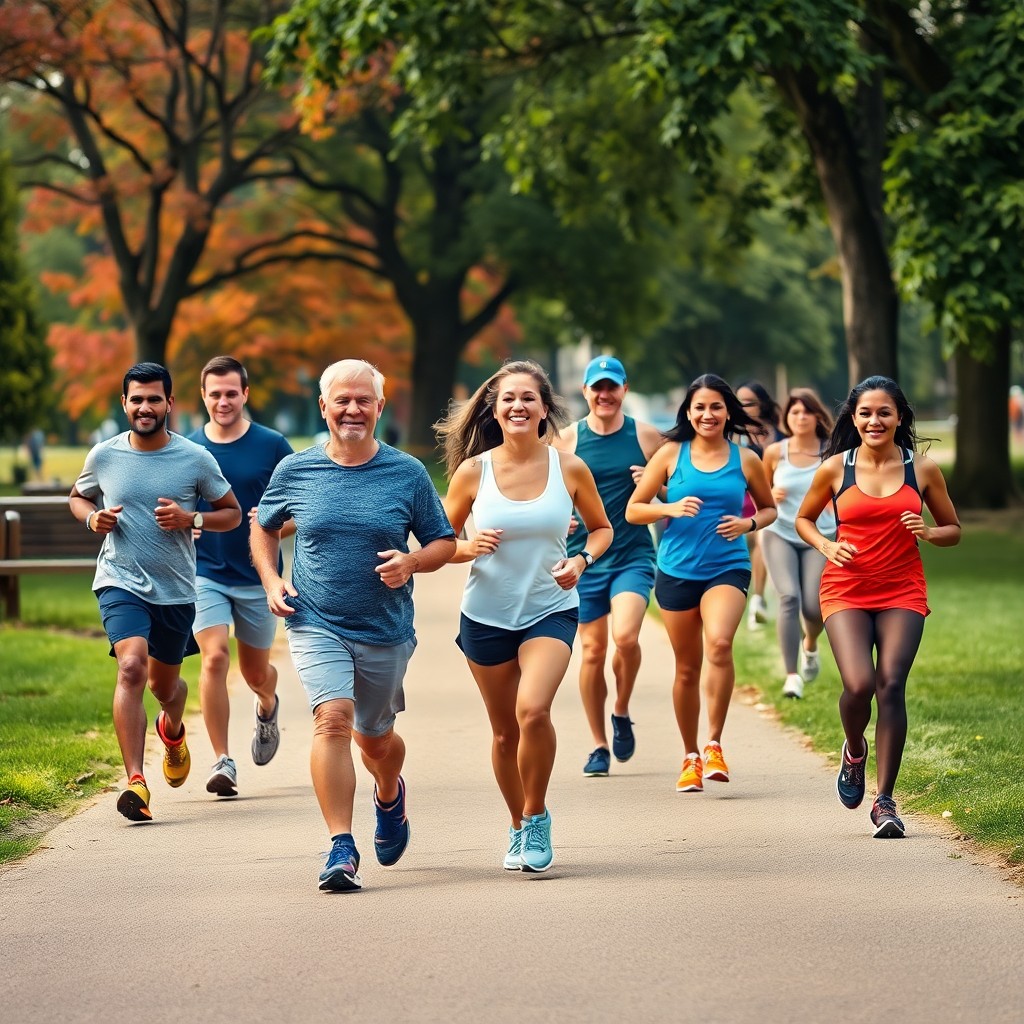As you sit on your couch, scrolling through social media, you can’t help but feel a pang of guilt when you see friends posting about their latest marathon achievements.
You wish you could be more like them, but the thought of starting a fitness journey seems daunting.
What if you’re not a “runner”?
What if you’re not even sure where to begin?
The good news is that you don’t need to be a fitness enthusiast to get started.
You can take the first step – literally – towards a healthier lifestyle, and it begins with a simple walk.
Let’s show you how walking can be the catalyst for a transformative journey from couch to 5K, and how it can empower you to take control of your fitness goals.
Why Walking is the Perfect Starting Point
Before you assume that running is the only way to achieve significant fitness gains, think again.
Walking can be just as effective, if not more so, for those who are new to exercise or have mobility limitations.
To begin your fitness journey, you don’t need to dive headfirst into intense workouts or expensive gym memberships.
Walking is the perfect starting point because it’s accessible, low-impact, and requires minimal equipment.
You can start with short walks and gradually increase your distance and intensity, making it an ideal way to build confidence and endurance.
The Science Behind Couch to 5K
Clearly, the Couch to 5K program is more than just a trendy fitness fad.
It’s rooted in scientific principles that have been proven to deliver results.
Any successful fitness journey relies on gradual progression.
Among the most effective strategies for achieving success in the Couch to 5K program is combining walking and running.
This approach enables you to build endurance, strengthen your cardiovascular system, and boost your confidence.
But what makes this combination so potent?
By alternating between walking and running, you’re able to push yourself beyond your perceived limits while still allowing for recovery and rebuilding.
This harmonious balance is key to unlocking your full potential and achieving a successful transition from couch to 5K.
The Benefits of a Structured Program
Gradually introducing new challenges and exercises is vital to avoiding plateaus and maintaining motivation.
The Couch to 5K program provides a structured framework, guiding you through a series of achievable milestones and celebrating your successes along the way.
Results-driven individuals thrive on accountability and clear direction.

The Physical Benefits of Walking
- Walking for about 30 minutes a day can reduce the risk of heart disease, stroke, and high blood pressure by 30-40%.
- Walking an average of 10,000 steps daily can enhance energy levels and overall endurance.
- Walking strengthens muscles, particularly in the legs, hips, and lower back, improving balance, posture, and mobility.
- Regular walking can decrease the risk of chronic diseases, including type 2 diabetes and certain cancers, by up to 50%.
- Walking helps lower the risk of cardiovascular disease by improving blood lipid profiles, blood pressure, and overall cardiovascular health.
The Mental and Emotional Benefits of Walking
- Emotional Transformation: Walking leads to a profound emotional shift, enhancing overall well-being.
- Release of Endorphins: The activity releases “feel-good” hormones that help alleviate symptoms of anxiety and depression.
- Sense of Calm: Walking promotes a feeling of calm, replacing stress and uncertainty with hope and optimism.
- Combating Mental Fatigue: Walking increases blood flow to the brain, improving cognitive function and mental clarity.
- Increased Focus and Alertness: Regular walking makes you more focused and better equipped to tackle challenges.
- Enhanced Creativity: The increased oxygenation of the brain fosters creativity, leading to new ideas and innovative solutions during walks.
- Overcoming Mental Barriers: Walking helps break down barriers, instilling a sense of accomplishment and pride in your abilities.
- Incremental Progress: The Couch to 5K program allows for a series of small victories that build confidence over time.
Creating a Walking Habit
- Establish a Routine: Aim to walk at least three times a week, allowing for rest days in between.
- Consistency and Patience: Gradually increase the frequency and duration of your walks as you progress.
- Achievable Targets: Set specific, manageable goals, like walking for 10 minutes or reaching a certain number of steps.
- Track Your Progress: Use a pedometer, fitness tracker, or mobile app to monitor growth and stay motivated.
- Designate a Walking Time: Set aside specific times for walking, such as during lunch breaks, early mornings, or after dinner.
- Choose Safe and Enjoyable Routes: Look for convenient locations like local parks or quiet streets.
- Get Creative with Scheduling: Wake up earlier or explore nearby trails on weekends to find opportunities to walk.
- Involve Friends or Family: Invite someone to join you for increased enjoyment and accountability.

Overcoming Common Barriers to Walking
- Recognize barriers like bad weather, low energy, or fear of embarrassment.
- Develop strategies by finding indoor walking routes, scheduling walks with a friend for accountability, and rewarding yourself for milestones.
- Address weather concerns by investing in waterproof gear or locating indoor walking spaces and manage energy levels by starting with shorter walks and gradually increasing duration.
- Choose footwear with good arch support, cushioning, and breathability; wear breathable, moisture-wicking fabrics, and consider good walking socks, a water-resistant jacket, and a hat or visor for sun protection.
- Feeling comfortable and confident in your gear will encourage consistency in your walking routine.
Additional Tips for a Safe and Enjoyable Walk
- Always walk facing traffic and stay alert for potential hazards.
- Carry a phone and ID with you in case of an emergency.
- Assume that drivers may not always see you, so be cautious when crossing roads.
Transitioning from Walking to Running
Many walkers eventually reach a point where they’re ready to take their fitness journey to the next level by incorporating running into their routine.
This transition can be both exciting and intimidating, but with a gradual approach, you can successfully make the leap from walking to running.
Knowing When to Start Running
Transitioning to running too quickly can lead to burnout or injury, so it’s vital to know when you’re ready.
Pay attention to your body and celebrate small victories along the way.
When you can comfortably walk for 30 minutes without feeling exhausted, it may be time to introduce short bursts of running into your routine.
Incorporating Intervals of Running
To ease into running, try incorporating intervals of jogging into your walks.
Start with short bursts of 1-2 minutes of jogging followed by 2-3 minutes of walking.
As you build endurance, you can gradually increase the duration and frequency of your running intervals.
Start with small goals, like jogging for 5 minutes without stopping, and reward yourself when you achieve them.
This will help you stay motivated and encouraged throughout the process.
Be patient, and don’t be too hard on yourself if you don’t see immediate results – every step forward is a success.

Maintaining Consistency and Motivation
Create a schedule and stick to it, even if it’s just 10-15 minutes of walking or running per day.
Celebrate your progress, no matter how small, and remind yourself why you started this journey in the first place.
Share your goals with friends and family and ask for their support.
Having a supportive community behind you can make all the difference in staying committed to your fitness journey.
Overcoming Common Challenges
Always remember that behind every great achievement lies a bit of discomfort.
As you start walking regularly, you may experience some soreness and fatigue, especially if you’re new to exercise.
This is a sign that your body is adapting to the new demands you’re placing on it.
Managing Expectations and Staying Motivated
About halfway through your Couch to 5K program, you may start to feel like you’re not making progress as quickly as you’d like.
It’s necessary to set realistic expectations and celebrate small victories along the way to stay motivated.
Further, try to focus on how far you’ve come rather than how far you still have to go.
Remind yourself why you started this journey in the first place, and let that motivation carry you through the tough days.
Finding Support and Accountability
Soreness and fatigue are much easier to overcome when you have a support system cheering you on.
Find a walking buddy, join a fitness group, or share your progress with friends and family to stay accountable and motivated.
The sense of community and camaraderie you’ll develop with like-minded individuals will help you push through challenging times and make the journey to 5K much more enjoyable.
Preparing for Your First 5K
Now that you’ve made the decision to take the first step towards a healthier lifestyle, it’s time to prepare for your first 5K event.
This milestone marks a significant achievement in your fitness journey, and with proper preparation, you’ll be ready to crush it!
Nutrition and Hydration Strategies
- Nourishment is the key to unlocking your full potential.
- Focus on consuming whole, unprocessed foods like fruits, vegetables, whole grains, lean proteins, and healthy fats.
- Aim to include complex carbohydrates, protein, and healthy fats in each meal to provide sustained energy and support muscle function.
- Aim to drink 16-20 ounces of water 1-2 hours before exercise.
- Drink 8-10 ounces of water every 10-15 minutes during exercise.
- Consume a sports drink or coconut water if exercising for over an hour.
Summing up
Upon reflecting on your journey from couch to 5K, you’ll realize that the power to transform your fitness lies in the simplest of actions – taking that first step.
By committing to a walking routine, you’ve not only improved your physical health but also unlocked a sense of accomplishment and confidence that will propel you forward.
As you look back on the progress you’ve made, you’ll be amazed at how far you’ve come, and the best part?
You did it all by putting one foot in front of the other.










